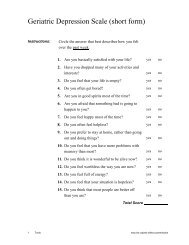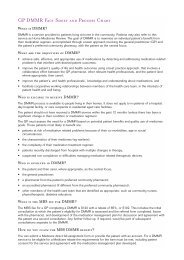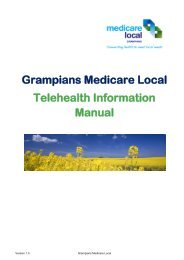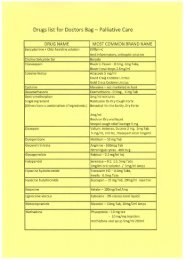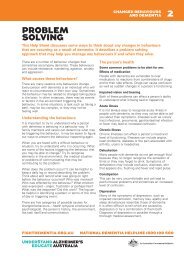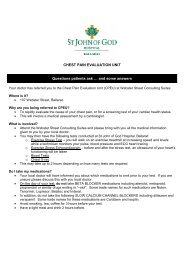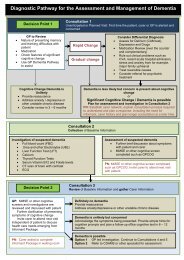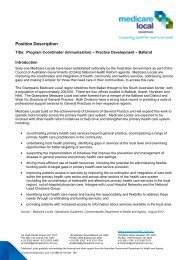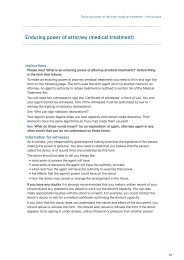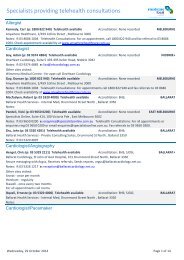Doctor's Bag: Palliative Care Information booklet - Grampians ...
Doctor's Bag: Palliative Care Information booklet - Grampians ...
Doctor's Bag: Palliative Care Information booklet - Grampians ...
You also want an ePaper? Increase the reach of your titles
YUMPU automatically turns print PDFs into web optimized ePapers that Google loves.
PALLIATIVE<br />
CARE<br />
INFORMATION
Index<br />
Introduction 4<br />
Symptom Control 5<br />
Gastro-Intestinal Symptoms 7<br />
Respiratory Symptoms 11<br />
Cognitive and Emotional 15<br />
Pain<br />
• Including Opioid conversion chart<br />
19<br />
Living Well Discussions – Advance Directives 23<br />
Resources<br />
• Including drug/common brand names list<br />
27<br />
<strong>Grampians</strong> Region <strong>Palliative</strong> <strong>Care</strong> Consortium<br />
Referral Pathway<br />
31<br />
<strong>Palliative</strong> care regional services - links 34
Introduction<br />
Acknowledgements:<br />
• Ballarat & District Division of General Practice<br />
• Adelaide North East Division of General Practice<br />
• <strong>Grampians</strong> Region <strong>Palliative</strong> <strong>Care</strong> Consortium<br />
• <strong>Grampians</strong> Regional <strong>Palliative</strong> <strong>Care</strong> Team<br />
• <strong>Palliative</strong> <strong>Care</strong> Victoria<br />
• <strong>Care</strong> Search Website (www.caresearch.com.au)<br />
• Therapeutic Guidelines Limited – <strong>Palliative</strong> <strong>Care</strong><br />
• End of Life/<strong>Palliative</strong> Education Resource Centre<br />
What is <strong>Palliative</strong> <strong>Care</strong>?<br />
<strong>Palliative</strong> <strong>Care</strong> Victoria describes <strong>Palliative</strong> <strong>Care</strong> as<br />
“Any special needs of a person who has a life-threatening illness. The focus is not<br />
on curing them but on treating their symptoms by making them comfortable, by<br />
controlling their pain and by helping them to make changes that will make their life<br />
easier. <strong>Palliative</strong> <strong>Care</strong> aims to make the person feel in control of their treatment and their<br />
quality of life. It involves family and friends, recognising that they too may need help in<br />
coping with the illness of someone they love. <strong>Palliative</strong> <strong>Care</strong> will also be there to offer<br />
help and support during the grieving process.<br />
<strong>Palliative</strong> <strong>Care</strong> can be provided in the person’s own home, at a specialist in-patient<br />
hospice unit, or at some other health facility, depending on where the person is living,<br />
and where they choose to die.”<br />
‘Principles of a good death’, are:<br />
• to have an idea of when death is coming and what can be expected<br />
• to be able to retain reasonable control of what happens<br />
• to be afforded dignity and privacy<br />
• to have control of pain and other symptoms<br />
• to have access to necessary information and expertise<br />
• to have access to any spiritual or emotional support required<br />
• to have access to ‘hospice style’ quality care in any location<br />
• to have control over who is present and who shares the end<br />
• to be able to issue advance directives to ensure one’s wishes are respected<br />
• to have time to say goodbye and to arrange important things<br />
• to be able to leave when it is time and not to have life prolonged pointlessly.<br />
Effective <strong>Palliative</strong> <strong>Care</strong> can ensure these principles are maintained and followed.
Symptom<br />
Control<br />
5
Individualised Treatment<br />
Individualising treatment depends on:<br />
Symptom<br />
Control<br />
• The available options (eg radiotherapy,<br />
chemotherapy)<br />
• Weighing benefits against burdens for each<br />
patient<br />
• The wishes of the patient and family<br />
• Optimal symptom control requires a<br />
multidisciplinary approach.<br />
Attention to Detail<br />
Evaluation<br />
Evaluate the symptom<br />
What are the likely causes (remembering a symptom<br />
may be due to disease progression, to treatment and<br />
medications or to intercurrent illness)? Accept the<br />
patient’s description of the symptom. What options<br />
are there to modify and are there any other factors<br />
impacting on the severity of the symptom?<br />
Evaluate the patient<br />
How far has the disease progressed? Is there a<br />
temporary relapse, which may be reversible or the<br />
terminal stage? What is the patient’s understanding<br />
of and response to the symptom?<br />
Explanation<br />
Informing the patient about the likely cause of the<br />
symptom can reduce their level of anxiety. A new<br />
symptom does not necessarily mean the disease is<br />
worse, but if it does, it may provide an opportunity<br />
to discuss the implications and prognosis, and<br />
prompt review of the patient’s life goals and<br />
priorities.<br />
Even small improvements in symptom control may<br />
be worthwhile. Thoroughness and fine tuning are<br />
important.<br />
Monitoring of Progress<br />
An important facet of care is a proactive approach<br />
to symptom control. Review the patient, their<br />
symptoms and their therapy frequently, as the<br />
situation of a patient with a terminal illness may<br />
change quickly. New symptoms can emerge and<br />
old symptoms recede.<br />
Rapid Dose Escalation<br />
There is a need to recognise extreme situations<br />
of distress in a dying patient. In these situations,<br />
an urgent response is required, with rapid dose<br />
titration and dose escalation over a short period of<br />
time if necessary.<br />
Discussion<br />
Discuss the treatment options and the likely<br />
outcomes with the patient. The following questions<br />
should be addressed:<br />
• What is the best outcome with the proposed<br />
treatment?<br />
• What is the possibility of no change or<br />
deterioration with the proposed treatment?<br />
• What will be required? (eg tests, hospitalisation,<br />
more tablets)<br />
• What if nothing is done about this symptom?
Gastro-intestinal<br />
Symptoms<br />
7
Gastro-intestinal<br />
Symptoms<br />
Oral Symptoms<br />
Oral problems can compromise the quality of life of a patient with a terminal illness. Simple symptomatic<br />
improvements can dramatically benefit the patient, with improved appetite, easier eating and an improved<br />
sense of wellbeing.<br />
Management of oral symptoms includes meticulous mouth care:<br />
• Frequent mouth washes – mouth swabs and water is usually sufficient<br />
• Moistening the oral cavity – small sips of fluids<br />
• Gentle teeth brushing<br />
• Induce saliva flow via sugar-free chewing gum, frozen lemon slices, frozen tonic water etc<br />
• Applying lanoline-based preparations or lip balms<br />
• Using choline salicylate mouth gel or toothpaste<br />
Symptomatic treatment:<br />
Benzydamine+chlorhexidine solution 10 to 15 mL Rinse and spit – 4 hourly<br />
Lignocaine viscous 2% 10 to 15 mL Rinse and spit – 4 hourly<br />
Aspirin or paracetamol gargles<br />
Choline salicylate gel<br />
4 hourly<br />
Applied 4 to 6 hours.<br />
Anorexia<br />
Anorexia and weight loss in advanced disease are among the most recognised and troubling symptoms for<br />
patients and caregivers. The loss of weight is seen as a sign of advancing disease and a cause of death and<br />
‘death by starvation’ is a common misconception. The reason that the person is not eating is often because<br />
they are dying.<br />
Management includes avoiding measuring weight in advanced disease. Patients know already they are losing<br />
weight and it is unnecessary to focus on this. Explaining the distinction between dehydration and thirst, and<br />
malnutrition and anorexia is important. Identify any causes and treat them accordingly ie nausea and vomiting<br />
etc.<br />
Pharmacological treatment of anorexia include:<br />
Metoclopramide 10 mg Orally, 3 times daily before food<br />
Domperidone 10mg Orally, 3 times daily before meals
Nausea and Vomiting<br />
Nausea may be intermittent or persistent either with or without vomiting. Nausea and vomiting can arise<br />
from all parts of the gastrointestinal tract. Assessment of the cause of nausea and management of the cause<br />
are essential.<br />
General management can include:<br />
• Review the patient’s medication and consider stopping drugs that can induce nausea<br />
• Nausea arising from anxiety may be reduced with discussions and behavioural therapies.<br />
• Patients with nausea and vomiting from external pressure on the stomach or a delay in emptying can<br />
benefit from consuming small amounts of food and drink regularly. Pureed foods may also be of benefit if<br />
the patient cannot tolerate solid food.<br />
Common antiemetics used:<br />
Haloperidol<br />
Metoclopramide<br />
Dopamine antagonist,<br />
works at chemoreceptor<br />
trigger zone<br />
Prokinetic but also<br />
dopamine antagonist<br />
Nausea due to drugs,<br />
metabolic disorders,<br />
sepsis, bowel obstructions<br />
Opioids, gastric irritation,<br />
gastric stasis, partial bowel<br />
obstruction, constipation<br />
Cyclizine Works at vomiting centre Vestibular component,<br />
small bowel obstruction<br />
Ondansetron<br />
Chemoreceptor trigger<br />
zone and the gut<br />
Chemotherapy and<br />
radiotherapy<br />
0.5-5.0 mg/day (oral or SC)<br />
10 mg 4 hourly (oral/SC) or<br />
50mg up to 4 times per day<br />
(oral/SC)<br />
50 mg twice per day (oral/SC),<br />
max 200 mg/day<br />
4-8 mg twice per day (oral/SC)<br />
Constipation<br />
In <strong>Palliative</strong> patients, aetiology is usually multifactorial and laxatives need to be used early, in sufficient doses<br />
and often in combination.<br />
General measures that can help avoid constipation:<br />
• Encourage the patient to toilet regularly at the same time each day. Have the patient sit upright.<br />
• Ensure adequate hydration and optimise the level of fibre in the diet.<br />
• Encourage general activity by good control of other symptoms.<br />
• Seek a remediable cause, such as lack of privacy, pain, poor mobility, dehydration and medications.<br />
Laxatives for Constipation<br />
Mode of action Oral Agents Dosage Suppository/enema Dosage<br />
Predominant<br />
Glycerol<br />
As required<br />
softening<br />
Predominant<br />
stimulant<br />
Paraffin<br />
Fybogel<br />
Coloxyl<br />
Lactulose<br />
Epsom salts<br />
Senokot<br />
Bisacodyl<br />
30 to 60 mL daily<br />
3.5 g sachet daily<br />
8 mg 4-6 daily<br />
10-30 mL 2-3 daily<br />
5-15 g daily<br />
5.5 mg/g granules<br />
5 mg tablets 2-4 daily<br />
Coloxyl with Senna<br />
Glycerine/Microlax<br />
Sodium phosphate<br />
Bisacodyl<br />
10mg as required<br />
5mL as required<br />
5mL as required<br />
10mg as required
Notes
Respiratory<br />
Symptoms<br />
11
Respiratory<br />
Symptoms<br />
Respiratory Secretions<br />
Problems related to respiratory secretions can be caused by infection or aspiration, or by pooling of normal<br />
oropharyngeal secretions in a patient who is weak or unable to swallow or cough effectively (for instance in<br />
motor neurone disease) or who has a reduced state of consciousness. The latter situation is common as death<br />
approaches (‘death rattle’). Pulmonary oedema also causes increased respiratory secretions<br />
Pharmacological treatment for respiratory secretions include:<br />
Hyoscine hydrobromide 0.4mg S/C 3 to 4 hourly prn<br />
Hyoscine butylbromide 10-20mg S/C 4 hourly prn<br />
Glycopyrronium 0.2mg S/C (max 1.2mg/24 hours)<br />
General management can include:<br />
• Repositioning the patient from side to side in a semi-upright position is recommended as a nursing<br />
strategy for patients with terminal secretions.<br />
• Suctioning of the oropharynx is occasionally useful, but it often causes patient distress.<br />
• Counselling of relatives and caregivers is important, and reassurance that the patient is not aware of the<br />
distress can usually be given.<br />
Dyspnoea<br />
Dyspnoea (shortness of breath) is described as ‘an uncomfortable awareness of breathing’. It is a subjective<br />
symptom which may not correlate with measurable physical abnormalities such as hypoxia. Treating the<br />
dominant cause of breathlessness, including the contributing co-morbidities, is likely to be most effective, but<br />
is not always possible.<br />
(Opioids in low doses)<br />
Morphine, commencing at 2.5mg– titrate up to effect Orally or S/C<br />
(Patient may experience relief, however physically they may still look ‘short of breath’)<br />
(Associated Anxiety)<br />
Diazepam 2mg Orally or rectally twice daily<br />
Clonazepam 0.25-0.5mg Orally or S/C twice daily<br />
Midazolam 1-5mg S/C as hourly boluses or by continuous infusion, starting dose<br />
5mg (rarely sedating) to 20mg (usually sedating) per 24 hours
Cough<br />
Cough in palliative care patients is often caused by<br />
infection, pleural effusion, or the direct effects of<br />
malignancy on the lung or airways. Co-morbidities<br />
such as Chronic Obstructive Pulmonary Disease<br />
(COPD) and cardiac failure may also contribute,<br />
and should be optimised. Antibiotic treatment of<br />
infection may sometimes give good palliation of<br />
infected secretions.<br />
The investigation and management of cough<br />
may differ depending on the person’s illness<br />
stage and wishes for treatment. Active treatment<br />
of malignancy as appropriate with surgery,<br />
chemotherapy or radiotherapy, or by drainage of<br />
pleural effusion, may effectively treat coughing in<br />
patients who are well enough.<br />
Pharmacological treatment for coughing include:<br />
(Dry, non-productive cough)<br />
• Cough suppression with opioids or opioid<br />
analogues:<br />
»» Dextromethorphan syrup<br />
»» Pholcodine or codeine linctus<br />
»» Morphine 1-2.5mg orally, 1-2 hours prn<br />
(Moist productive cough)<br />
• Humidification: steam, inhalations (eg<br />
eucalyptus), nebulised saline<br />
• Bronchodilators (eg: Salbutamol)<br />
• Antibiotics – consider for symptom relief<br />
Haemoptysis:<br />
• Consider palliative radiotherapy for recurrent<br />
bleeding from tumours<br />
• Catastrophic haemorrhage: Anxiolytic,<br />
Morphine<br />
• Dark towels to conceal bleeding and to<br />
minimise visual impact for patient and family
Notes
Cognitive and<br />
Emotional<br />
15
Delirium and Terminal Restlessness<br />
Delirium is defined as a condition of disturbed<br />
consciousness, with reduced ability to focus, sustain<br />
or shift attention.<br />
Delirium may be:<br />
Cognitive and<br />
Emotional<br />
• Hyperactive (presenting with agitation,<br />
hyperarousal, and restlessness), or<br />
• Hypoactive (presenting with drowsiness,<br />
lethargy and reduced levels of arousal), or<br />
• A mixed pattern in which the symptoms<br />
fluctuate between hyperactive and hypoactive.<br />
Delirium is extremely common in palliative care<br />
patients. It becomes more frequent towards the<br />
end of life, and is associated with a worsening<br />
prognosis. The diagnosis is often missed, or may be<br />
confused with depression or dementia. Hypoactive<br />
delirium in particular is under-diagnosed.<br />
Terminal restlessness is a cluster of symptoms; most<br />
often described as agitation and altered mental<br />
state, which occurs close to the end of life. There is<br />
no agreed definition of this condition.<br />
Factors which should be considered as possible<br />
contributors to delirium/Terminal Restlessness in a<br />
palliative care patient, and treated as appropriate,<br />
include:<br />
• Infection<br />
• Metabolic and biochemical disorders (eg,<br />
renal failure, hypercalcaemia, hyponatraemia,<br />
dehydration, hypoxia, hypercapnia)<br />
• Hepatic encephalopathy<br />
• Structural cerebral disease (eg, primary or<br />
secondary cancer, leptomeningeal disease,<br />
radiotherapy to the brain)<br />
• Medications (eg, psychoactive medications<br />
such as benzodiazepines, opioids, steroids,<br />
antidepressants, or medications with an<br />
anticholinergic effect)<br />
• Drug withdrawal (eg, alcohol, benzodiazepine,<br />
nicotine)<br />
• Environmental (hospital admission,<br />
uncorrected sensory deficits eg, vision and<br />
hearing).<br />
Delirium is defined as<br />
a condition of disturbed<br />
consciousness, with<br />
reduced ability to focus,<br />
sustain or shift attention.
Pharmacological and nonpharmacological management, as well as the treatment of reversible causes, should<br />
be considered simultaneously.<br />
Nonpharmacological measures include:<br />
• A peaceful, familiar environment<br />
• The presence of people well-known to the patient<br />
• Appropriate music<br />
• Avoidance of the dark and of bright lights<br />
• Explanation, reassurance and regular reorientation<br />
• Minimising sensory deficits (eg hearing, vision loss) by providing aids<br />
• Explanation to and support of family is necessary so they may be reassured and also assist in patient care.<br />
Pharmacological treatment for Delirium/Terminal Restlessness include:<br />
Haloperidol 1.5-10mg Orally daily in divided doses<br />
Olanzepine 2.5-10mg Orally daily<br />
Diazepam 2.5-10mg Orally or rectally twice daily<br />
Clonazepam 0.25-0.5mg Orally or S/C twice daily<br />
Midazolam<br />
2.5-5mg<br />
S/C as hourly boluses or by continuous infusion, starting dose 5mg<br />
(rarely sedating) to 20mg (usually sedating) per 24 hours
Notes
Pain<br />
19
Pain<br />
Opioid Conversion Chart<br />
TO Codeine Morphine Oxycodone Hydromorphone Fentanyl<br />
PO PO SC PO SC PO SC TD<br />
FROM mg/day mg/day mg/day mg/day mg/day mg/day mg/day mcg/hr<br />
Codeine PO mg/day 8 20 12 20 40 120 24<br />
Morphine PO mg/day 8 2.5 1.5 2.5 5 15 3<br />
Morphine SC mg/day 20 2.5 0.6 1 2 6 1.2<br />
Oxycodone PO mg/day 12 1.5 0.6 1.67 3.33 10 2<br />
Oxycodone SC mg/day 20 2.5 1 1.67 2 6 1.2<br />
Hydromorphone PO mg/day 40 5 2 3.33 2 3 0.6<br />
Hydromorphone SC mg/day 120 15 6 10 6 3 0.2<br />
Fentanyl TD mcg/hour 24 3 1.2 2 1.2 0.6 0.2<br />
Multiply Divide<br />
Opioid Conversion Chart Instructions<br />
1. Add current opioid doses to get total milligrams over 24 hrs (for Fentanyl note the total hourly rate in mcg)<br />
2. Use conversion chart -<br />
1. Identify current opioid in column on far left<br />
2. Scan across the column corresponding to new opioid<br />
3. Note conversion factor and whether to be multiplied or divided<br />
3. Multiply or divide current opioid total by conversion factor. This will give the dose of the new opioid in<br />
milligrams per 24 hours<br />
4. Divide 24 hr dose by appropriate number ie 2 for BD dosing of 6 for q4H dosing or 100% breakthrough dose<br />
When changing patients from one opioid to another, it is safer to initially give less than the calculated<br />
equivalent dosage and increase if needed.<br />
NOTE: Conversion from morphine to fentanyl is more variable than the other conversions in this list.<br />
One reason is that morphine depends on renal excretions whereas fentanyl does not. For example, the<br />
prescribing information for fentanyl patches states that a 25mcg/hr patch is equivalent to a 30-120mg oral<br />
dose of morphine daily.<br />
Obtain specialist advice if uncertain.
Pain<br />
Treat constant pain with regular analgesia. Different types<br />
of pain respond to different analgesics. Psycho-social<br />
factors like anxiety or depression, which may reduce<br />
tolerance to pain or be exacerbated by pain, must also be<br />
assessed and treated<br />
A step-by-step guide to pain control<br />
1. Mild pain of many causes will respond to paracetamol.<br />
2. Identify if the type of pain can best be treated by a<br />
specific treatment:<br />
• pain from bone metastases radiotherapy<br />
• smooth muscle colic antimuscarinic<br />
• infection such as cellulitis antibiotic<br />
• pathological fracture radiotherapy or surgical<br />
fixation<br />
• raised intracranial pressure corticosteroids<br />
3. For moderate pain, consider an NSAID e.g. diclofenac<br />
50mg t.d.s. if an inflammatory process is thought to be<br />
involved and there are no contraindications to an NSAID:<br />
• bone metastases<br />
• musculo-skeletal pain<br />
4. For more severe pain start a strong opioid and titrate<br />
dose:<br />
• morphine PO or SC is the usual first-line opioid.<br />
5. If this does not relieve the pain or the opioid dose has<br />
been escalated to the maximum tolerable side effects -<br />
consider:<br />
• adding an NSAID if not already tried<br />
• morphine-resistant pain<br />
• underlying depression or fear lowering the<br />
patient’s tolerance to pain<br />
• if disseminated bone pain, consider<br />
hypercalcaemia which lowers pain threshold<br />
• a new pain may have developed<br />
• vomiting preventing drug absorption<br />
• poor compliance to medication<br />
Common types of pain<br />
Visceral pain<br />
Tumour infiltration of the viscera causes a constant dull<br />
pain, poorly localised, that usually responds very well to<br />
opioids.<br />
Liver pain may also be due to stretching of the liver<br />
capsule. Dexamethasone 4-6mg o.d. often helps the pain.<br />
Raised intracranial pressure pain is due to stretching of the<br />
meninges and may respond well to dexamethasone.<br />
Pancreatic malignancy may produce pain unrelieved by<br />
opioids, due to retroperitoneal nerve involvement. A<br />
coeliac plexus block has a high success rate.<br />
Bone pain<br />
Often described like ‘toothache’, bone pain is usually<br />
well localised, and local tenderness may be elicited.<br />
Musculo-skeletal pains<br />
Commonly occur due to general debility. NSAIDs are<br />
often successful but a strong opioid may be needed as<br />
well.<br />
Soft tissue involvement<br />
(e.g. chest wall involvement in breast or lung cancer)<br />
Dexamethasone may be more effective than a NSAID<br />
(usually in combination with an opioid). Consider<br />
radiotherapy referral.<br />
Infection<br />
Pain from cellulitis or deep pelvic infection is best<br />
treated with an antibiotic if appropriate. NSAIDs may<br />
also be helpful.<br />
Smooth muscle colic<br />
Opioids are often ineffective for intestinal colic, biliary<br />
colic and bladder spasms.<br />
Nerve pain (Neuropathic pain)<br />
Often but not always associated with sensory changes.<br />
Neuropathic pain is often at least partially responsive to<br />
opioids, which should be titrated first.<br />
Odynophagia (painful dysphagia)<br />
Causes include painful mouth, radiotherapy-induced<br />
oesophagitis, candidiasis, acid reflux and oesophageal<br />
spasm. Pain from oesophageal spasm may respond to<br />
nifedipine or glyceryl trinitrate.<br />
Ischaemic pain<br />
When surgery is inappropriate for ischaemic pain<br />
from a gangrenous foot, pain relief can be difficult.<br />
Spinal analgesia with an opioid and local anaesthetic<br />
is probably the treatment of choice. It may not always<br />
be possible. Alternatives to consider include liberal use<br />
of local anaesthetic (e.g. Emla cream) smothered over<br />
the affected part, or a local anaesthetic subcutaneous<br />
infusion. Ketamine and methadone (as described under<br />
Neuropathic pain) may be helpful.<br />
Episodic pain<br />
Pain that varies significantly with time may be:<br />
• ‘end-of-dose’ pain requiring a review of<br />
analgesic dose or regimen<br />
• pleuritic pain ( NSAID, corticosteroid,<br />
antibiotic, intercostal nerve block, interpleural<br />
anaesthetic infusion)<br />
• pain on movement from bone disease or nerve<br />
compression<br />
• pain on movement may respond better to<br />
NSAIDs than opioids<br />
• skin hypersensitisation - neuropathic or<br />
inflammatory<br />
• pain related to dressing changes or procedures<br />
• Entonox (nitrous oxide) may be helpful for<br />
predictable pain e.g. dressing changes or<br />
procedures
Notes
Living Well<br />
Discussions<br />
Advance Directives<br />
23
Living Well<br />
Discussions<br />
Advance Directives<br />
The Living Well Discussion:<br />
Doctor-patient discussions about end of life<br />
treatment are often framed as a choice between<br />
“medical treatments vs. treatment withdrawal”.<br />
When framed in this manner, treatment withdrawal<br />
is a negative choice that often implies giving up,<br />
abandonment, not giving the doctor a chance to<br />
do his or her job and not caring; this option would<br />
seem to be no option at all.<br />
The physician can reframe the doctor-patient<br />
dialogue about end of life treatment by starting<br />
a conversation with the patient focused on the<br />
question “How can we help you live well?” The goal<br />
of the living well interview is to elicit the patient’s<br />
perspective regarding how they want to spend<br />
their remaining time. Treatment decisions are then<br />
discussed within this broader context of patient<br />
goals and hopes. Treatments become tools for<br />
achieving patient goals.<br />
When: Begin soon after the diagnosis of a lifelimiting<br />
condition<br />
Who: Physician and patient with support from<br />
others: family, carer, friends, nurse, chaplain, etc.<br />
How: Begin by expressing a need and interest to<br />
understand the patient’s views. The physician’s<br />
initial goal is to develop a broad understanding of<br />
the patient’s hopes and goals.<br />
What to say: Given that we now know about your<br />
medical condition….<br />
• How can we help you live well? What makes<br />
you happy?<br />
• Maintaining or fulfilling what activities or<br />
experiences are most important for you to feel<br />
your life has quality, or for you to live well?<br />
• What fears and worries do you have about your<br />
illness or medical care?<br />
• If you have to choose between living longer<br />
and quality of life, how would you approach<br />
this balance?<br />
• What needs or services would you like to<br />
discuss?<br />
• What do you hope for your family?<br />
• Are there any special events or activities that<br />
you are looking forward to?<br />
• What sustains you when you face serious<br />
challenges in your life?<br />
• Do you have religious or spiritual beliefs that<br />
are important to you?<br />
• In what way do you feel you could make this<br />
time especially meaningful for you?<br />
Advance <strong>Care</strong> Planning/Legal<br />
Considerations<br />
<strong>Palliative</strong> care emphasises advance care planning. It<br />
helps patients and their families to:<br />
• Consider the kind of care that fits with their<br />
values<br />
• Make decisions about future care, and review<br />
possible scenarios in relation to their own<br />
situation and their values<br />
• Identify a proxy decision maker, if one is<br />
available and appropriate<br />
• Discuss organ donation, wills, funerals, and<br />
other matters related to the end of life.<br />
Written information about a patient’s wishes may<br />
need to be available for emergencies, and for<br />
when a patient is transferred between different<br />
settings of care. Ensuring this happens is part of the<br />
advance care planning process.<br />
TIP - Advance care planning simply involves<br />
discussing a person’s wishes and ensuring that<br />
the family or other proxy decision-maker is aware<br />
of these wishes. Make sure they are noted in the<br />
clinical record.<br />
Legal considerations<br />
Advance care planning processes can vary between<br />
states and territories. The relevant Acts for Victoria<br />
are the Medical Treatment Act 1988 and the<br />
Guardianship and Administration Act 1986.
General comments:<br />
• A competent adult has the right to refuse<br />
medical treatment.<br />
• A competent adult can sign a legally binding<br />
refusal of medical treatment but not palliative<br />
care under the Medical Treatment Act 1988 in<br />
Victoria.<br />
• A competent adult has the right to appoint<br />
a substitute decision-maker, who can make<br />
decisions regarding their medical treatment<br />
should they become incapable of making<br />
these decisions themselves. In Victoria they can<br />
appoint:<br />
»» A Medical Enduring Power of Attorney<br />
(MEPOA also referred to as an agent);<br />
»» An Enduring Guardian or <br />
»» In writing, a “person responsible”<br />
• If a person has not appointed an enduring<br />
power of attorney (medical treatment) or an<br />
Enduring Guardian (with the power to make<br />
medical decisions), the responsibility for<br />
medical treatment decisions falls to the “person<br />
responsible”.<br />
• The “person responsible” cannot refuse medical<br />
treatment on a patient’s behalf in circumstances<br />
where the patient is dying and unconscious,<br />
and the patient considers the medical treatment<br />
unwarranted or considers that the treatment<br />
could cause unreasonable distress.<br />
Appointing a Decision Maker:<br />
• To appoint a MEPOA or agent the person must<br />
be over 18 years of age, able to understand<br />
the nature and effect of the power of attorney,<br />
capable of choosing an agent.<br />
• A doctor can witness the appointment of a<br />
MEPOA by a competent individual.<br />
• A person may also choose to nominate an<br />
alternate agent who will only make decisions if<br />
the agent is unavailable, or incapable of making<br />
decisions. The alternate agent can only make<br />
decisions for the person if they sign a statutory<br />
declaration stating that the agent is either dead,<br />
incompetent or cannot be contacted.<br />
Advance Directives<br />
• A patient can plan and document their choices<br />
for future medical treatment by completing<br />
a Statement of Choices (or similar) document<br />
that captures their future medical treatment<br />
wishes and other requests for psycho-social<br />
spiritual care, document this in a letter, via<br />
discussions with their Medical Enduring<br />
Power of Attorney, family and/or health care<br />
professionals.<br />
• Under schedule 1 of the Medical Treatment Act<br />
1988, competent patients can also complete a<br />
Refusal of Treatment Certificate. This Certificate<br />
must be related to a current illness only but<br />
cannot refuse palliative care and is legally<br />
binding and cannot be overridden by family<br />
or doctors. This is a particularly useful tool if a<br />
person does not have a family or friend whom<br />
they could nominate as their MEPOA.<br />
• Legally appointed MEPOAs can also refuse<br />
treatment on a person’s behalf and this must<br />
be documented on a Refusal of Treatment<br />
Certificate (Schedule 3). If a Schedule 1 or 3 is<br />
completed a copy needs to be placed in the<br />
patient’s Medical Record. If a patient or an<br />
agent wants to cancel a certificate, this must<br />
be stated to a doctor or another person and<br />
the certificate should then be destroyed.<br />
• The Act protects medical practitioners who<br />
act in good faith and in accordance with the<br />
patients express wishes.<br />
<strong>Information</strong><br />
For more information please contact Office of<br />
the Public Advocate on:<br />
Phone: 1300 309 337<br />
(24 hour Emergency Service)<br />
Fax: 1300 787 510<br />
www.publicadvocate.vic.gov.au<br />
Once nominated, the agent and/or alternate agent<br />
has the power to:<br />
• Refuse medical treatment on the person’s<br />
behalf if the treatment would cause the person<br />
unreasonable distress or if the agent believes<br />
on reasonable grounds that the person would<br />
consider the treatment to be unwarranted,<br />
agree to medical treatment on the person’s<br />
behalf.<br />
• The agent does not have the power to make<br />
non-medical decisions, nor does he or she have<br />
the power to refuse palliative care.
Notes
Resources<br />
27
Resources<br />
Useful references to use in conjunction<br />
with these guidelines are State and<br />
Commonwealth standards as well as:<br />
1.<br />
2.<br />
Therapeutic Guidelines<br />
<strong>Palliative</strong> <strong>Care</strong>, Version 3<br />
www.tg.org.au<br />
<strong>Care</strong>Search<br />
(<strong>Palliative</strong> <strong>Care</strong> Knowledge Network)<br />
<strong>Care</strong>Search is an online resource of palliative<br />
care information and evidence:<br />
www.caresearch.com.au<br />
3.<br />
4.<br />
5.<br />
6.<br />
7.<br />
<strong>Palliative</strong> <strong>Care</strong> Australia<br />
<strong>Palliative</strong> <strong>Care</strong> Australia is the peak national<br />
organisation representing the interests and<br />
aspirations of all who share the ideal of quality<br />
care at the end of life for all:<br />
www.palliativecare.org.au<br />
<strong>Palliative</strong> <strong>Care</strong> Victoria<br />
<strong>Palliative</strong> <strong>Care</strong> Victoria Inc (PCV) is the peak body<br />
representing palliative care providers, consumers<br />
and their families and those with an interest in<br />
palliative care in Victoria:<br />
www.pallcarevic.asn.au<br />
<strong>Grampians</strong> Region <strong>Palliative</strong> <strong>Care</strong> Consortium<br />
<strong>Grampians</strong> Region <strong>Palliative</strong> <strong>Care</strong> Consortium is an<br />
alliance between all the services in the <strong>Grampians</strong><br />
Region that provide direct palliative care services:<br />
www.grampianspalliativecare.com.au<br />
<strong>Grampians</strong> Regional <strong>Palliative</strong> <strong>Care</strong> Team<br />
works closely with the <strong>Palliative</strong> <strong>Care</strong> Service<br />
Providers across the region to assist with ongoing<br />
development and delivery of effective palliative<br />
care services:<br />
www.grampianspalliativecare.com.au<br />
EPERC<br />
End of Life <strong>Palliative</strong> Education Resource Centre<br />
The purpose of EPERC is to share educational<br />
resource material among the community of health<br />
professional educators involved in palliative care<br />
education:<br />
www.eperc.mcw.edu<br />
Drug List<br />
DRUG NAME<br />
Benzydamine + Chlorhexidine solution<br />
Choline Salicylate Gel<br />
Clonazepam<br />
Codeine linctus<br />
Cyclizine<br />
Dexamethasone<br />
Dextromethorphan<br />
Single ingredient<br />
(Others have a combination of ingredients.)<br />
MOST COMMON BRAND NAME<br />
Difflam-C<br />
Anti inflammatory, antiseptic solution<br />
Bonjela<br />
Rivotril, Paxam - 0.5mg, 2mg Tabs,<br />
Rivotril oral drops 2.5mg/ml<br />
Actacode 5 mg/ml<br />
David Craig Codeine Linctus<br />
Gold Cross Codeine Linctus<br />
Marazine – not marketed in Aust<br />
Dexmethsone - 0.5mg , 4 mg Tab<br />
3mg/ml mixtures<br />
Robitussin Dx Dry Cough Forte<br />
Benadryl for the family, Dry Forte<br />
2mg/ml<br />
Bisolvon Dry oral liquid<br />
Strepsil cough relief lozenge 5 mg
DRUG NAME<br />
MOST COMMON BRAND NAME<br />
Diazepam<br />
Valium, Antenex, Ducene 2 mg, 5mg Tab<br />
5 mg/ml, 2ml Inj , Diazepam elixir 1mg/ml<br />
Domperidone<br />
Motilium – 10 mg Tab<br />
Glyceryl trinitrate<br />
Anginine - 600mcg Tab<br />
Nitrolingual spray - 400 mcg<br />
Glycopyrrolate<br />
Robinul – 0.2 mg/ml Inj.<br />
Haloperidol<br />
Serenace – 0.5, 1.5, 5mg Tabs<br />
2mg/ml oral solution / 5mg/ml Amps<br />
Hyoscine hydrobromide<br />
Travacalm HO – 0.3mg Tabs,<br />
Kwells - 0.3mg Tabs<br />
Hyoscine butylbromide<br />
Buscopan – 10 mg Tab, 20mg/ml injection<br />
Ketamine<br />
Ketalar – 100mg/1ml Amp<br />
Lignocaine viscous<br />
Xylocaine – 2% viscous (oral liquid)<br />
Metoclopramide<br />
Maxolon – 10mg Tab, 10mg/2ml Amps<br />
Methadone<br />
Physeptone – 10 mg tab<br />
– 10 mg/mg injection,<br />
methadone oral syrup 5mg/ml 200ml<br />
Midazolam<br />
Hypnovel – 5 mg/5ml, 5mg/ml, 15mg/3ml, 50mg/10ml Injection<br />
Morphine sulphate<br />
Kapanol – long acting capsules – 10mg, 20mg, 50mg, 100mg<br />
MS Contin – short acting tabs 5,10,15,30,60, 100 & 200 mg<br />
Ordine, Mixture Oral – 1, 2,5,10 mg/ml<br />
Morphine Sulphate injection – 5, 10, 15, 30 mg/ml<br />
All used frequently dependent on situation<br />
Nifedipine<br />
Adalat , Adefin – 10mg , 20mg Tab<br />
Adalat Oros CR 20,30, 60mg Tab<br />
NSAIDs<br />
Ibuprofen Nurofen 200 mg *<br />
Brufen 400 mg *<br />
Diclofenac Voltaren / Fenac *<br />
Indomethacin<br />
Indocid / Arthrexin<br />
Naproxen<br />
Naprosyn / Inza<br />
Proxyn SR<br />
Piroxicam<br />
Feldene / Mobilis<br />
Celecoxib Celebrex *<br />
Meloxicam<br />
Mobic / Movalis<br />
* most common<br />
Olanzapine<br />
Zyprexa 2.5, 5, 7.5, 10mg Tab. 5, 10mg Wafer<br />
Ondansetron<br />
Zofran – 4 mg/8mg Tab<br />
Pholcodine<br />
3 mg/ml<br />
Duro-tuss Dry Cough Liquid Forte<br />
Please note: this is not a comprehensive list.<br />
1 mg/ml<br />
Duro-tuss Dry<br />
Linctus Tussinol<br />
Gold Cross Pholcodine Linctus
Notes
<strong>Grampians</strong> Region <strong>Palliative</strong> <strong>Care</strong> Consortium<br />
Referral Pathway<br />
31
<strong>Grampians</strong> Region <strong>Palliative</strong> <strong>Care</strong> Consortium<br />
Referral Pathway
<strong>Grampians</strong> Region <strong>Palliative</strong> <strong>Care</strong> Consortium - Referral Pathway<br />
Referral from Family, Friends, GP’s. Community Health, DNS, RACF, Acute/Sub-Acute wards,<br />
Allied Health, Medical Specialists, Other Health providers ie MS Society, MND<br />
Referrals received via a VSRF, SCTT or RIMS Referral<br />
Tool to appropriate Local Service Provider<br />
Djerriwarrh <strong>Palliative</strong> <strong>Care</strong> Ballarat Hospice <strong>Care</strong> Inc<br />
<strong>Grampians</strong> Regional<br />
<strong>Palliative</strong> <strong>Care</strong> Team<br />
Ballarat Health Services<br />
St John of God Hospital<br />
Central <strong>Grampians</strong><br />
<strong>Palliative</strong> <strong>Care</strong><br />
Liaise with GP and or Specialist<br />
Initial<br />
Assessment<br />
<strong>Care</strong> Plan<br />
Developed<br />
Monitor and Review<br />
Routine <strong>Care</strong> attended<br />
Unresolved<br />
Complex <strong>Care</strong><br />
Referral to<br />
<strong>Grampians</strong> Regional<br />
<strong>Palliative</strong> <strong>Care</strong> Team<br />
Initial Consult<br />
Liaise with GP’s and other Service Providers involved<br />
Inpatient<br />
Admission<br />
required<br />
<strong>Palliative</strong> <strong>Care</strong><br />
Service Providers<br />
services Increased<br />
Community<br />
based services<br />
implemented<br />
Liaise with GP,<br />
Specialist and<br />
source of Referral<br />
Inpatient<br />
Admission<br />
required<br />
<strong>Palliative</strong> <strong>Care</strong><br />
Service Providers<br />
services Increased<br />
Wimmera Hospice <strong>Care</strong><br />
New <strong>Care</strong> Plans<br />
for Community<br />
based services
<strong>Palliative</strong> <strong>Care</strong><br />
<strong>Information</strong><br />
<strong>Palliative</strong> <strong>Care</strong> Services located<br />
within <strong>Grampians</strong> Region:<br />
Referrals to Community Services are required on<br />
RIMS/SCOTT/VSRF via electronic or fax. Referrals will<br />
only be processes during normal business hours.<br />
Ballarat Hospice <strong>Care</strong><br />
312 Drummond Street South, Ballarat 3350<br />
P O Box 96, Ballarat 3353<br />
Ph: 03 5333 1118<br />
Fx: 03 5333 1119<br />
Em: eo@ballarathospice.com<br />
Wb: www.ballarathospice.com<br />
Central <strong>Grampians</strong> <strong>Palliative</strong> <strong>Care</strong><br />
Girdlestone Street, Ararat 3377<br />
P O Box 155, Ararat 3377<br />
Ph: 03 5352 9465<br />
Fx: 03 5352 9319<br />
Em: cgpc@eghs.net.au<br />
Wb: www.eghs.net.au<br />
Djerriwarrh Health Services and<br />
<strong>Palliative</strong> <strong>Care</strong><br />
Grant Street, Bacchus Marsh 3340<br />
P O Box 330, Bacchus Marsh 3340<br />
Ph: 03 5367 2000<br />
Fx: 03 5367 9641<br />
Em: pamr@djhs.org.au<br />
Wb: www.meltonhealth.com.au<br />
Gandarra <strong>Palliative</strong> <strong>Care</strong> Unit<br />
Ballarat Health Services (Queen Elizabeth Centre)<br />
102 Ascot Street South, Ballarat 3350<br />
Ph: 03 5320 3895<br />
Fx: 03 5320 3763<br />
Wb: www.bhs.org.au<br />
<strong>Grampians</strong> Region <strong>Palliative</strong><br />
<strong>Care</strong> Consortium<br />
The <strong>Grampians</strong> Region <strong>Palliative</strong> <strong>Care</strong> Consortium<br />
has a role in the strategic direction for palliative<br />
care within the region. It is made up of all the<br />
specialist palliative care services (inpatient and<br />
community) in the <strong>Grampians</strong> Region. The aim of<br />
the consortium is strategic planning in palliative<br />
care which includes advocacy, education, research,<br />
quality, special projects, clinical issues and<br />
improvement in practice.<br />
Ph: 0428 737 330<br />
Em: gpalcareconsort@gmail.com<br />
Wb: www.grampianspalliativecare.com.au<br />
St John of God Healthcare<br />
101 Drummond Street North, Ballarat 3350<br />
Ph: 03 5320 2130<br />
Fx: 03 5320 2832<br />
Em: joanne.howard@sjog.org.au<br />
Wb: www.sjog.org.au<br />
Wimmera Hospice <strong>Care</strong><br />
Baillie Street, Horsham 3400<br />
Ph: 03 5381 9363<br />
Fx: 03 5381 9170<br />
Em: hospice@whcg.org.au<br />
Wb: www.wimmerahealth.com<br />
<strong>Grampians</strong> Regional <strong>Palliative</strong><br />
<strong>Care</strong> Team<br />
<strong>Palliative</strong> <strong>Care</strong> Physicians:<br />
Dr David Brumley and Dr Greg Mewett<br />
Ballarat Health Services (Queen Elizabeth Centre)<br />
102 Ascot Street South, Ballarat 3350<br />
Ph: 03 5320 3553<br />
Fx: 03 5320 6493<br />
Em: info@grampianspalliativecare.com.au<br />
Wb: www.grampianspalliativecare.com.au<br />
AGPN acknowledges the financial contributions of the Australian Government Department of Health and Aging




